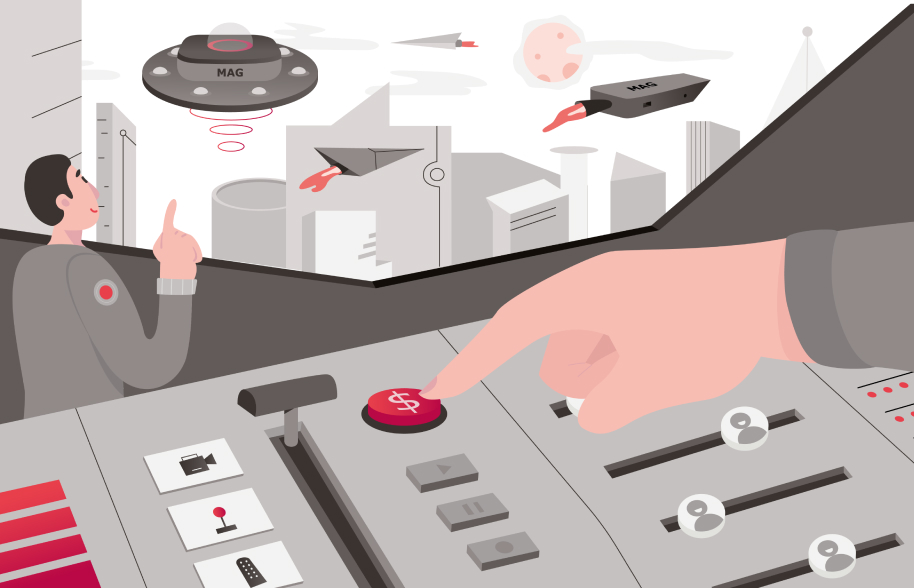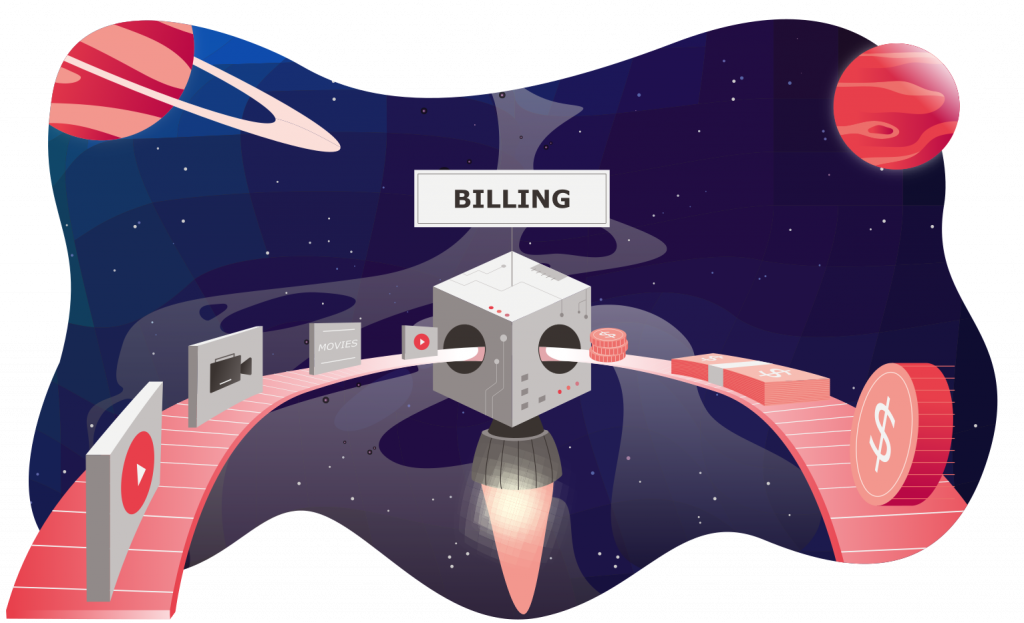Material 3
Middleware: the core of your service
Why an operator needs middleware and billing as well as how these solutions influence the number of clients and device support.
Operator
vlog
Middleware is an essential part of your project. Discover how the solution is put into practice
and how the choice of middleware impacts the project’s success. An existing IPTV operator shares their experience.
Warning: var_dump() expects at least 1 parameter, 0 given in /home/infomir/web/academy.infomir.eu/public_html/wp-content/themes/understrap-child-master/flex-template/material/content.php on line 6
What an IPTV/OTT solution middleware is

IPTV is a means of delivering content over a local network.
Middleware is a type of software that operators use to run their television platforms. With middleware, the provider can manage content, services, client devices, and apps, as well as gather statistics and coordinate the operation of the service’s other components.
IPTV/OTT operators have started using middleware relatively recently. Since the mid-90s, viewers have been able to pause, rewind, and record TV broadcasts. However, these features were integrated into client devices back then.
By the 2000s, too many features were becoming available for client devices to support: there was just not enough space for built-in parental controls, VoD, and apps like karaoke and weather forecasts.
To avoid having to endlessly modify their set-top boxes every time they added a new feature, operators started using middleware. Now it handles all kinds of interactive features, and adding something new can be done easily through the middleware without modifying devices. IPTV/OTT services have grown to become websites, and client devices — browsers, tasked with playing back the content.
Warning: var_dump() expects at least 1 parameter, 0 given in /home/infomir/web/academy.infomir.eu/public_html/wp-content/themes/understrap-child-master/flex-template/material/content.php on line 6
What middleware does
Middleware allows operators to manage their content and subscriber accounts, gather statistics, and control their service’s main components.
Middleware handles the following tasks:

Content management
Middleware enables the addition of TV channels, the uploading of movies and TV shows, their grouping by genres, and the use of age restriction settings.
When the subscriber puts on a new movie or TV show, their device communicates with the middleware, then the system sends a link to the content with the corresponding bitrate and audio track.

User management
The solution enables the operator to set up service packages and connect them to subscriber accounts.

Statistics and reports
In the statistics section, the operator can monitor traffic, views, and subscriber preferences. For instance, you can easily track TV show popularity and see if subscribers will be interested to see its next season.

Advertising and notifications
The system enables the implementation of advertising and notifications for subscribers, e.g., about scheduled maintenance or changing terms under their plan.

Service coordination
Middleware connects all the IPTV/OTT project components. It also enables data exchange between them, e.g., setting permissions for client devices to access content.

User interface
The operator can manage user experience through middleware. Everything the subscriber sees on their screen comes from the middleware.
Warning: var_dump() expects at least 1 parameter, 0 given in /home/infomir/web/academy.infomir.eu/public_html/wp-content/themes/understrap-child-master/flex-template/material/content.php on line 6
Middleware is an operator-side tool. Subscribers are usually unaware of its existence.
Warning: var_dump() expects at least 1 parameter, 0 given in /home/infomir/web/academy.infomir.eu/public_html/wp-content/themes/understrap-child-master/flex-template/material/content.php on line 6
Why having a billing system is a must

With a billing system, you can accept payments from subscribers, manage subscription plans, and block non-payers. The system provides access to payment gateways — the services that check subscriber payment data online and enable online payments.
Billing systems are a separate component of video services and are not usually pre-installed on the middleware. It’s nearly impossible to create a one-size-fits-all billing solution for global use because every country has its own currency and legislation. Therefore, operators can choose the billing solution themselves — the middleware just needs to have an API for its integration.
Middleware and billing systems are closely connected and continuously exchange data. The billing system notifies whether the user has paid the subscription fee or not, and middleware enables access to the data concerning active subscription services for billing. Billing also controls payments: if the client fails to pay for the services, the middleware can remind them to pay or even block the account.
Sometimes operators allow users to manage subscription plans, activate new services themselves, and make remote payments. To that end, a subscriber dashboard module can be integrated into the middleware. If the operator offers internet and telephony in addition to TV, the billing system will aggregate the fees for all activated subscriber services into one bill.
Billing systems store the following data:
- Customer account balance
- Subscription plan terms
- Activated services
- Charges and payments
- Special offers and discounts
Billing systems enable the following:
- Monitoring of the service’s revenue
- Client payments
- Subscription plan management
- Activated service tracking
- Apply deductions, special offers or discounts on billing
When selecting a billing system, make sure that it’s straightforward for users to make payments. Choose an online billing service that is compatible with your country’s payment operators.
Warning: var_dump() expects at least 1 parameter, 0 given in /home/infomir/web/academy.infomir.eu/public_html/wp-content/themes/understrap-child-master/flex-template/material/content.php on line 6
Warning: var_dump() expects at least 1 parameter, 0 given in /home/infomir/web/academy.infomir.eu/public_html/wp-content/themes/understrap-child-master/flex-template/material/content.php on line 6
What the source code determines
Middleware source code is the software code written in one of the programming languages. Its availability determines if the operator can integrate new functionality by themselves or only the solution supplier can do it.
If the source code is partially open, the operator can modify the middleware and add self-developed apps. To this end, they may use in-house developers or outsource the development entirely. In the case of a ‘closed-source’ solution, only the vendor will be able to integrate new functionality.
Closed source
The provider has access only to the basic functionality of middleware. Vendor’s assistance is needed to implement new features, e.g., UI modification or a weather widget.
Partially open source
The system can be modified and extended with new modules. The operator can add third-party modules, e.g., billing, via an API.
Warning: var_dump() expects at least 1 parameter, 0 given in /home/infomir/web/academy.infomir.eu/public_html/wp-content/themes/understrap-child-master/flex-template/material/content.php on line 6
What middleware architecture determines
Middleware can gravitate toward one of two architecture types: modular or monolithic.
A modular middleware consists of autonomous components, and a monolithic one fuses them into an indivisible whole. The middleware architecture determines whether the operator will be able to modify its modules and add new ones without affecting the system as a whole. A modular middleware is built from independent blocks, like a construction set. It enables easier integration of new features, as its every block can be modified without affecting the system as a whole. If the operator decides to integrate a VoD module, the line TV and TimeShift won’t be affected.
In the monolithic middleware, all components are closely interconnected. It’s impossible to change a module independently of the system. If the developer modifies a solution like this, all subscribers will get the update. Such is the advantage of monolithic middleware: once it is updated, all subscribers can benefit from its new features.
Example
An operator has decided to offer a TV Archive feature to their subscribers. Integrated into a monolithic middleware, it will become available to all subscribers at once. With modular middleware, the operator will be able to provide the feature to a group of select subscribers.
A modular middleware is easier to extend and thus is a better fit for modern IPTV/OTT operators.
Warning: var_dump() expects at least 1 parameter, 0 given in /home/infomir/web/academy.infomir.eu/public_html/wp-content/themes/understrap-child-master/flex-template/material/content.php on line 6
Where you can get middleware
Operators use self-developed middleware or turnkey solutions. The former is better on the feature side, but the latter is cheaper and enables an almost immediate launch of the business.
Turnkey middleware has many advantages:
- It takes the operator not months, but weeks to launch a project.
- It’s cheaper than creating a self-developed middleware from scratch.
- Turnkey middleware is regularly updated.
- Turnkey middleware usually comes bundled with technical support.
Only major operators with a subscriber base of hundreds of thousands or even millions can afford to develop middleware from scratch. The advantage, though, is that the operator gets precisely the features they need.
Key takeaways
- Middleware is an essential element of video services. It connects the project components and enables data exchange between them.
- Middleware empowers the operator to manage content and user accounts as well as to ensure subscribers’ access to the services they order and track stats.
- Billing is a service that is integrated into the middleware to accept payments.
- Turnkey modular middleware is an optimal choice for launching a project. Solutions of this kind optimize initial investments and make the services easily scalable going forward.
In our next article, we will look at all kinds of client devices and discover why every operator needs multiscreen.
